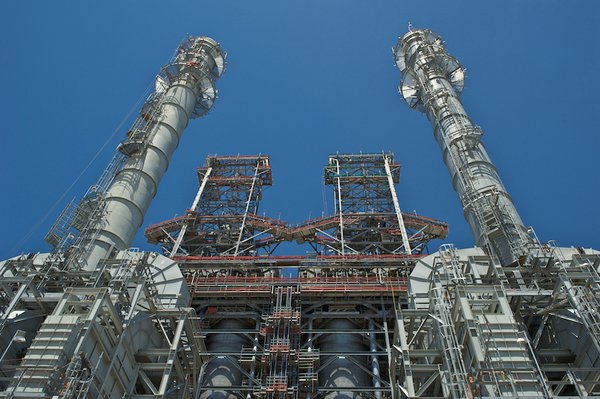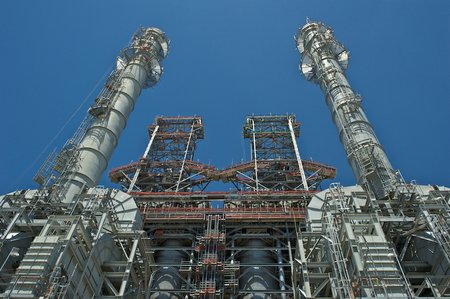Chevron Phillips Chemical Co. has reached a settlement with the US Environmental Protection Agency (EPA) and the US Department of Justice (DOJ) to resolve a series of claims alleging the operator violated the US Clean Air Act (CAA) and associated state air pollution control laws by illegally emitting thousands of tonnes of harmful pollutants via flaring at three of its Texas petrochemical manufacturing plants.
As part of the Mar. 9 judicial settlement, Chevron Phillips signed a consent decree lodged in the Southern District Court of Texas under which the operator has agreed to spend an estimated $118 million to complete necessary pollution-controlling upgrades and implement air-quality monitoring systems at its Port Arthur, Sweeny, and Cedar Bayou plants located in Port Arthur, Sweeny, and Baytown, Tex., respectively, EPA and DOJ said.
Designed to improve Chevron Phillips’s flaring practices and compliance—an EPA priority under its Creating Clean Air for Communities National Compliance Initiative—the proposed consent decree requires the operator to reduce flaring by minimizing the volume of waste gas sent to the flares. Chevron Phillips also must improve combustion efficiency of its flares for when flaring is necessary, EPA said.
The operator also will pay a $3.4-million civil penalty for the past violations no later than 30 days after the effective date of the consent decree that—currently within its 30-day public comment period scheduled to end on Apr. 14—still remains subject to final court approval, according to a Mar. 15 notice in the Federal Register.
Once Chevron Phillips fully implements pollution controls at the three Texas chemical plants as required by the consent decree, EPA estimates emissions of climate-change-causing greenhouse gases (GHGs)—including carbon dioxide (CO2), methane, and ethane—will fall by more than 75,000 tonnes/year (tpy). The settlement also should result in reduced emissions of volatile organic compounds (VOCs) by 1,528 tpy, of nitrogen oxides by 20 tpy, and of hazardous air pollutants (HAPs)—including benzene—by 158 tpy, EPA said.
The March settlement arises from EPA’s original complaint against Chevron Phillips, in which the agency alleges the operator, at various time between 2009 and the present, performed improperly reported, unreported, and-or unpermitted modifications at 18 flares located across the Port Arthur, Sweeny, and Cedar Bayou plants, triggering a chain of CAA-related noncompliance infractions, including violations of:
- New source review (NSR) requirements for newly constructed and modified sources of criteria air pollutants.
- Title V permitting requirements for NSR violations.
- Federal new source performance standard (NSPS), national emission standards for hazardous air pollutants (NESHAP), and maximum achievable control technology (MACT) requirements incorporated into the Title V permit related to monitoring to ensure flares are operated and maintained in conformance with their design.
- NSPS, NESHAP, and MACT requirements incorporated into the Title V permit related to operating flares consistent with good air pollution control practices.
- NSPS, NESHAP, and MACT requirements incorporated into the Title V permit related to combusting gas in flares with a net heating value (NHV) of 300 BTU/scf or greater.
Specifically, EPA alleges Chevron Phillips failed to properly operate and monitor the chemical plants’ industrial flares, which resulted in excess emissions of toxic pollution at the site. The complaint additionally claims the operator regularly oversteamed the flares and has failed to comply with other key operating constraints to ensure VOCs and HAPs contained in flare-bound gases are efficiently combusted.
Specific upgrades, implementations
Per the consent decree, Chevron Phillips has agreed to the following measures to reduce the amount of waste gas sent to flares at the Texas plants:
- At Cedar Bayou, the company will operate a flare gas recovery system that recovers and recycles gases instead of sending them for combustion in a flare. The system will allow the plant to reuse these gases as an internal fuel or a product for sale.
- At Port Arthur and Sweeny, Chevron Phillips will be required to amend its air quality permits to limit the flow of gas at selected flares.
- The company also will create waste minimization plans for the three plants that may further reduce flaring.
- For flaring that must occur, Chevron Phillips will install and operate instruments and monitoring systems to ensure that the gases sent to its flares are efficiently combusted.
- The company will also surround each of the three covered plants at their fence lines with a system of monitors to measure ambient levels of benzene—a carcinogen to which chronic exposure can cause numerous health impacts, including leukemia and adverse reproductive effects in women—as well as post these monitoring results via a publicly available website to provide neighboring communities with more information about their air quality.
- If fence-line monitoring data indicates high levels of benzene, Chevron Phillips will conduct a root cause analysis to determine the source and take corrective actions if emissions exceed certain thresholds.
According to the consent decree, however, Chevron Phillips already has undertaken a series of actions to reduce flare-related emissions at the trio of plants. These include:
- At all three plants, equipping each covered flare with smaller assist-steam controls (to optimize assist-steam injection at low waste-gas flow rates); implementing flare stewardship metrics (to reduce flaring); and optimizing process unit procedures and operations (to reduce flaring).
- At Cedar Bayou, changing supplies for flare sweep gas from nitrogen to plant fuel gas, resulting in reduced use of supplemental gas use and reduced emissions.
- At Port Arthur, replacing the type of catalyst used in acetylene converters, resulting in longer cycle times between regenerations and reduced emissions.
- At Port Arthur, switching the material for multiple dryer regenerations from nitrogen to a process fluid with a higher NHV, resulting in reduced use of supplemental gas and reduced emissions.
Environmental justice prioritized
The latest Tweet by Bloomberg states, ‘Despite surging gasoline prices, there may never be a new refinery built in the U.S. as policymakers move away from fossil fuels, Chevron CEO says.

“We haven’t had a refinery built in the United States since the 1970s,” Chief Executive Officer Mike Wirth said in an interview on Bloomberg TV. “My personal view is there will never be another new refinery built in the United States.”
The Biden administration has appealed to OPEC and the U.S. shale producers to pump more crude to help lower gasoline prices this year. But even if oil prices were to fall, the U.S. may not have enough refining capacity to the meet petroleum product demand. Refining margins have exploded to historically high levels in recent weeks amid lower product supplies from Russia and China and surging demand for gasoline and diesel.
And adding refining capacity is not easy, especially in the current environment, Wirth said.
“You’re looking at committing capital 10 years out, that will need decades to offer a return for shareholders, in a policy environment where governments around the world are saying: we don’t want these products,” he said. “We’re receiving mixed signals in these policy discussions.”
U.S. retail gasoline prices averaged $4.76 a gallon today, a record high and up 45% this year, according to AAA. East Coast stockpiles of diesel and gasoline inventories in the New York-region are at their lowest levels for this time of year since the early 1990s, raising the specter of fuel rationing, just as the U.S. enters summer driving season. Even with high prices, Wirth is seeing no signs of consumers pulling back.
“We’re still seeing real strength in demand” despite international air travel and Chinese consumption not yet back to their pre-pandemic levels, Wirth said. “Demand in our industry tends to move faster than supply in both directions. We saw that in 2020 and we’re seeing that today.”
Chevron couldn’t instantly increase production today even if it wanted to due to the considerable lead times in bringing on oil and gas wells, even in the short-cycle U.S. shale, Wirth said. The CEO expects to meet with the Biden administration when he’s in Washington next week.
“We need to sit down and have an honest conversation, a pragmatic and balanced conversation about the relationship between energy and economic prosperity, national security, and environmental protection,” Wirth said. “We need to recognize that all of those matter.”


